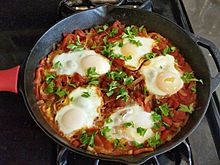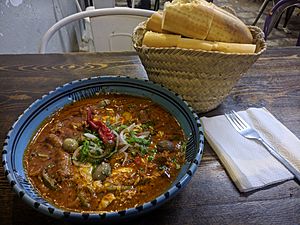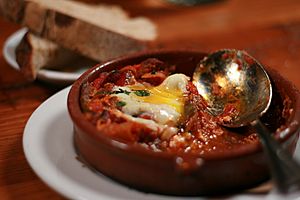Shakshouka facts for kids

Shakshouka in a cast iron pan
|
|
| Alternative names | Shakshuka, chakchouka |
|---|---|
| Type | Main dish |
| Region or state | Maghreb |
| Main ingredients | Tomatoes, harissa, eggs, olive oil |
Shakshouka (Arabic: شكشوكة : šakšūkah, also spelled shakshuka or chakchouka) is a Maghrebi dish of eggs poached in a sauce of tomatoes, olive oil, peppers, onion and garlic, commonly spiced with cumin, paprika and cayenne pepper. According to Joan Nathan, shakshouka originated in Ottoman North Africa in the mid-16th century after tomatoes were introduced to the region by Hernan Cortés as part of the Columbian exchange.
Contents
Etymology
The word shakshouka (Arabic: شَكْشُوكَةٌ) is a Maghrebi Arabic term for "a mixture". The exact provenance of the word is often contested, but, like the names of many Maghrebi dishes and terms, is believed to come from the language of the Amazigh (or Berber) people indigenous to the region. In the western Maghreb, it is referred to as bīd wu matiša (بيض ومطيشة "egg and tomato").
History
The origin of the dish remains a matter of some controversy with competing claims of Libyan, Moroccan, Tunisian, Turkish, Algerian and Yemeni origins. Tomatoes and peppers are notably New World ingredients that only became common ingredients in later centuries after the Columbian exchange.
Like their Muslim neighbors, Maghrebi Jews have also made shakshuka for centuries. North African Jewish immigrants in Israel brought the dish in the 1950s and 1960s, though it only became popularised on menus in the 1990s. Much of its current popularity in Israel is due to Bino Gabso, the son of Jewish emigrants from Tripoli, who in 1991 took over his father's restaurant in Jaffa and changed its name to Dr Shakshuka. Shakshuka is prominent among several dishes brought to Israel by Mizrahi populations that have been adapted to Israeli cuisine.
The dish has since been globally popularised, a trend that may in part have been helped by the 2012 cookbook on Jerusalem cuisine by Jewish Israeli chef Yotam Ottolenghi and his Palestinian business partner Sami Tamimi. Israeli food writer Gil Hovav, has credited the international popularity of dishes like shakshouka to Ottolenghi and Tamimi's book. Some have accused Israel of cultural appropriation which chef Michael Solomonov dismissed: "To say that this is stolen food – not only is it inaccurate, it’s just lazy. The real reason that everybody in that region cooks the way they do is because of the Ottomans."
Variations

Many variations of the basic sauce are possible, varying in spice and sweetness. Some cooks add preserved lemon, salty sheep milk cheeses, olives, harissa or a spicy sausage such as chorizo or merguez. Shakshouka is made with eggs which are commonly poached but can also be scrambled like the Turkish menemen.
Some variations of shakshouka can be made with lamb mince, toasted whole spices, yogurt and fresh herbs. Spices can include ground coriander, caraway, paprika, cumin and cayenne pepper. Tunisian cooks may add potatoes, broad beans, artichoke hearts or courgettes to the dish. The North African dish matbukha can be used as a base for shakshouka.
A shakhsouka made with a kosher version of Spam (called loof) was added to IDF army rations in the 1950s. Because eggs are the main ingredient, it is often on breakfast menus in English-speaking countries, but in the Arab world as well as Israel, it is also a popular evening meal, and like hummus and falafel, is a Levantine regional favorite. On the side, pickled vegetables and North African sausage called merguez might be served, or simply bread, with mint tea.
In Jewish culture, a large batch of tomato stew is made for the Sabbath dinner and the leftovers used the following morning to make a breakfast shakshouka with eggs. In Andalusian cuisine, the dish is known as huevos a la flamenca; this version includes chorizo and serrano ham. in Italian cuisine, there is a version of this dish called uova in purgatorio (eggs in purgatory) with tomato paste, anchovy, garlic and parsley and sometimes parmesan cheese.
See also
 In Spanish: Shakshuka para niños
In Spanish: Shakshuka para niños


